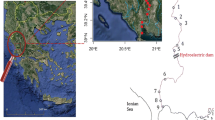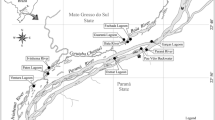Abstract
Ecomorphological changes as a result of natural perturbations in estuarine fish communities were investigated in two South African estuaries (Swartvlei and East Kleinemonde), both before and after the loss of aquatic macrophyte beds in these systems. The fish communities were analysed using an ecomorphological diversity index (EMI) and the results compared to a traditional index, the Shannon-Wiener diversity index. The EMI revealed that the major changes in fish community composition recorded in both estuaries were associated with quantitative variations at the species level. Both estuaries essentially lost their macrophyte beds and ended up with the same type of bottom habitat (bare sediment). In both cases the fish morphological variability decreased immediately after aquatic macrophyte loss and then increased to end above the initial value. The ecomorphological analysis appeared to be sensitive to major ecological disturbances that occurred during the study period and this was confirmed by the morphospace configuration. The results indicate that the ecomorphology of the fish community responds to habitat changes and that this change corresponds to alterations in the representation of the different feeding types. These findings therefore contribute to the measurement of morphological changes in estuarine fish assemblages as a result of habitat changes within the ecosystem and we propose that ecomorphological analyses add another dimension to the information provided by existing diversity indices in studying changing fish communities.






Similar content being viewed by others
References
Adams DC, Rohlf FJ, Slice D (2003) Geometric morphometrics: ten years of progress following the ‘Revolution’. It J Zool 71:5–16
Antonucci F, Costa C, Aguzzi J, Cautadella S (2009) Ecomorphology of morpho-functional relationships in the family of Sparidae: a quantitative statistic approach. J Morphol 270:843–855
Barnett A, Bellwood DR, Hoey AS (2006) Trophic ecomorphology of cardinalfish. Mar Ecol Prog Ser 322:249–257
Begon M, Harper JL, Townsend CR (1986) Ecology: individuals, populations and communities. Blackwell, Oxford
Bellwood DR, Wainwright PC, Fulton CJ, Hoey AS (2006) Functional versatility supports coral reef biodiversity. Proc R Soc B Biol Sci 273:101–107
Bock WJ (1990) From biologische anatomie to ecomorphology. Neth J Zool 40:254–277
Bohannan BJM, Hughes J (2003) New aproaches to analyzing microbial biodiversity data. Curr Opin Microbiol 6:282–287
Clarke KR, Warwick RM (1998) A taxonomic distinctness index and its statistical properties. J Appl Ecol 35:523–531
Clarke KR, Warwick RM (1999) The taxonomic distinctness measure of biodiversity, weighting of step lengths between hierarchical levels. Mar Ecol Prog Ser 184:21–29
Clarke KR, Warwick RM (2001) A further biodiversity index applicable to species lists, variation in taxonomic distinctness. Mar Ecol Prog Ser 216:265–278
Cornwell WK, Schwilk DW, Ackerly DD (2006) A trait-based test for habitat filtering: convex hull volume. Ecology 87:1465–1471
Costa C, Cautadella S (2007) Relationship between shape and trophic ecology of selected species of Sparids of the Caprolace coastal lagoon (Central Tyrrhenian Sea). Env Biol Fish 78:115–123
Ernst R, Linsenmair KE, Rodel MO (2006) Diversity erosion beyond the species level: dramatic loss of functional diversity after selective logging in two tropical amphibian communities. Biol Conserv 133:143–155
Flynn DFB, Gogol-Prokurat M, Nogeire T, Molinari N, Richers BT, Lin BB, Simpson N, Mayfield MM, DeClerck F (2009) Loss of functional diversity under land use intensification across multiple taxa. Ecol Lett 12:22–33
Fulton CJ, Bellwood DR, Wainwright PC (2001) The relationship between swimming ability and habitat use in wrasses (Labridae). Mar Biol 139:25–33
Gatz AJ (1979) Community organization in fishes as indicated by morphological features. Ecology 60:711–718
Gray JS (2000) The measurement of marine species diversity, with an application to the benthic fauna of the Norwegian continental shelf. J Exp Mar Biol Ecol 250:23–49
Green RH, Vascotto GL (1978) A method for the analysis of environmental factors controlling patterns of species composition in aquatic communities. Water Res 12:583–590
Hertel H (1966) Structure, form and movement. Reinhold, New York
James NC, Whitfield AK, Cowley PD (2008) Long-term stability of the fish assemblages in a warm-temperate South African estuary. Est Coast Shelf Sci 76:723–738
Karr JR, James FC (1975) Eco-morphological configurations and convergent evolution of species and communities. In: Cody ML, Diamond JM (eds) Ecology and evolution of communities. Harvard University Press, Cambridge, pp 258–291
Lindsey CC (1978) Form, function, and locomotory habits in fish. In: Hoar WS, Randall DJ (eds) Fish physiology: locomotion. Academic, New York, pp 1–100
Lombarte A, Olaso I, Bozzano A (2003) Ecomorphological trends in Artedidraconidae (Pisces: Perciformes: Notothenioidei) of the Weddell Sea. Ant Sci 15:211–218
Lombarte A, Palmer M, Matallanas J, Gómez-Zurita J, Morales-Nin B (2010) Ecomorphological trends and phylogenetic inertia of otolith sagittae in Nototheniidae. Environl Biol Fish 89:607–618
Lydy MJ, Crawford CG, Frey JW (2000) A comparison of selected diversity, similarity, and biotic indices for detecting changes in bentic-invertebrate community structure and stream quality. Arch Environ Comtam Toxicol 39:469–479
Macleod N, Forey PL (2002) Introduction: morphology, shape, and phylogenetics. In: Macleod N, Forey PL (eds) Morphology, shape and phylogeny. CRC, Boca Raton, pp 1–7
Magurran AE (1988) Ecological diversity and its measurement. Princenton University Press, New Jersey, p 179
Mason NWH, Lanoiselee C, Mouillot D, Irz P, Argillier C (2007) Functional characters combined with null models reveal inconsistency in mechanisms of species turnover in lacustrine fish communities. Oecologia 153:441–452
McGill BJ, Enquist BJ, Weiher E, Westoby M (2006) Rebuilding community ecology from functional traits. Trends Ecol Evol 21:178–185
Motta PJ, Kotrschal KM (1992) Correlative, experimental, and comparative evolutionary approaches in ecomorphology. Nether J Zool 42:400–415
Motta PJ, Clifton K, Hernandez P, Eggold BT (1995) Ecomorphological correlates in ten species of subtropical seagrass fishes: diet and microhabitat utilization. Env Biol Fish 44:37–60
Mouillot D, Gaillard S, Aliaume C, Verlaque M, Belscher T, Troussellier M, Chi TD (2005) Ability of taxonomic indices to determinate coastal lagoon environments based on macrophyte communities. Ecol Indic 5:1–17
Neige P (2003) Spatial patterns of disparity and diversity of the recent cuttlefishes (Cephalopoda) across the Old World. J Biogeogr 30:1125–1137
Norton SF, Luczkovich JJ, Motta PJ (1995) The role of ecomorphological studies in the comparative biology of fishes. Env Biol Fish 44:287–304
Olden JD, Poff NL, Bestgen KR (2008) Trait synergisms and the rarity, extirpation, and extinction risk of desert fishes. Ecology 89:847–856
Paddack MJ, Cowen RK, Sponaugle S (2006) Grazing pressure of herbivorous coral reef fishes on low coral-cover reefs. Coral Reefs 25:461–472
Petchey OL, Gaston KJ (2006) Functional diversity: back to basics and looking forward. Ecol Lett 9:741–758
Pouilly M, Lino F, Bretenoux JG, Rosales C (2003) Dietary-morphological relationships in a fish assemblage of the Bolivian Amazonian floodplain. J Fish Biol 62:1137–1158
Pulcini D, Costa C, Aguzzi J, Cataudella S (2007) Light and shape: a contribution to demonstrate morphological differences in diurnal and nocturnal Teleosts. J Morphol 269:375–385
Recasens L, Lombarte A, Sánchez P (2006) Teleostean fish composition and structure of an artificial reef and a natural rocky area in Catalonia (North Western Mediterranean). Bull Mar Sci 78:71–82
Rohlf FJ (2001) TPS Dig 1.31 and TPS relative wards software. Stony Brook, New York
Rohlf FJ (2003) tpsPLS, partial least-squares, version 1.12. Stony Brook, New York
Rohlf FJ, Marcus LF (2003) A revolution in morphometrics. Trends Ecol Evol 8:129–132
Schoener TW (1974) Resource partitioning in ecological communities. Science 1985:27–39
Shannon CE, Weaver W (1949) The mathematical theory of communication. University of Illinois Press, Urbana
Sheppard JN, James NC, Whitfield AK, Cowley PD (2011) What role do beds of submerged macrophytes play in structuring estuarine fish assemblages? Lessons from a warm-temperate South African estuary. Estuarine Coastal and Shelf Science 95:145–155
Sokal RR, Michener CD (1958) A statistical method for evaluating systematic relationships. Univ Kans Sci Bull 38:1409–1438
Sokal RR, Rohlf FJ (1962) The comparison of dendrograms by objective methods. Taxon 11:33–40
Somerfield PJ, Olsgard F, Carr MR (1997) A further examination of two new taxonomic distincness measures. Mar Ecol Prog Ser 154:303–306
Villéger S, Ramos-Miranda J, Flores-Hernández D, Mouillot D (2010) Contrasting changes in taxonomic vs. functional diversity of tropical fish communities after habitat degradation. Ecol Appl 20:1512–1522
Violle C, Navas ML, Vile D, Kazakou E, Fortunel C, Hummel I, Garnier E (2007) Let the concept of trait be functional! Oikos 116:882–892
Wagner CE, McIntyre PB, Buels KS, Gilbert DM, Michel E (2009) Diet predicts intestine length in Lake Tanganyika’s cichlid fishes. Funct Ecol 23:1122–1131
Wainwright PC, Richard BA (1995) Predicting patterns of prey use from morphology of fishes. Env Biol Fish 44:97–113
Wainwright PC, Bellwood DR, Westneat MW (2002) Ecomorphology of locomotion in labrid fishes. Environ Biol Fish 65:47–62
Warwick RM, Clarke KR (1995) New biodiversity measures reveal a decrease in taxonomic distinctness with increasing stress. Mar Ecol Prog Ser 129:301–305
Warwick RM, Clarke KR (1998) A taxonomic distinctness index and its statistical properties. J Appl Ecol 35:523–531
Webb CO (2000) Exploring the phylogenetic structure of ecological communities: an example for rain forest trees. Am Nat 156:145–155
Whitfield AK (1986) Fish community structure response to major habitat changes within the littoral zone of an estuarine coastal lake. Env Biol Fish 17:41–51
Whitfield AK (1992) A characterization of southern African estuarine systems. Sth Afr J Aquat Sci 18:89–103
Whitfield AK (1998) Biology and ecology of fishes in southern African estuaries. Ichthyol Monogr JLB Smith Inst Ichthyol 2:1–223
Whittaker RH (1960) Vegetation of the siskiyou mountains. Oregon and California. Ecol Monogr 30:279–338
Winemiller KO (1991) Ecomorphological diversification in lowland fresh-water fish assemblages from 5 biotic regions. Ecol Mongr 61:343–365
Zelditch ML, Sheets HD, Fink WL (2003) The ontogenic dynamics of shape disparity. Paleobiol 29:139–156
Acknowledgements
This work has been supported by the MEC CGL2004-0384-E project and National Research Foundation (NRF) of South Africa.
Author information
Authors and Affiliations
Corresponding author
Rights and permissions
About this article
Cite this article
Lombarte, A., Gordoa, A., Whitfield, A.K. et al. Ecomorphological analysis as a complementary tool to detect changes in fish communities following major perturbations in two South African estuarine systems. Environ Biol Fish 94, 601–614 (2012). https://doi.org/10.1007/s10641-011-9966-0
Received:
Accepted:
Published:
Issue Date:
DOI: https://doi.org/10.1007/s10641-011-9966-0




